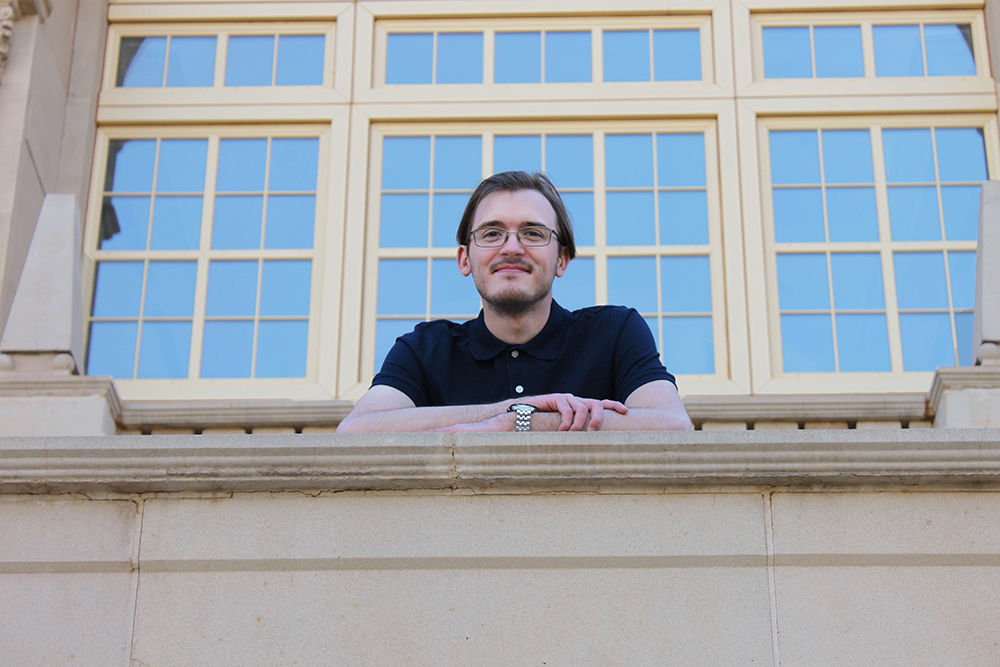Nicholas Clark Nominated to AMS Committee

Atmospheric Science Proves to Be Right Path for Grad Student
4.14.2022 | Toni Salama
The undergraduate experience is all about finding where you thrive. For Nicholas Clark, now an atmospheric science graduate student in the Department of Geosciences, the road to his best place took some unexpected turns.
“Even before being admitted into Texas Tech's undergraduate program,” Clark said, “I began looking into possible career choices for myself. Initially, I considered becoming a neurologist, then an architectural engineer, and finally a researcher.”
It's a path that eventually led Clark to major, with honors, in mathematics and minor in atmospheric science before entering grad school to concentrate on atmospheric science.
Fast forward to 2022: Clark has been nominated to serve as a student member on the American Meteorological Society (AMS) Committee for Measurements, with a three-year term beginning in April 2022.
Clark is well known to AMS, where he has presented his work at annual meetings three years in a row: 2020 in Boston, 2021 and 2022 in virtual mode. On the home front, Clark won third place in Texas Tech's 2021 3-Minute Thesis Competition for his presentation “Over the Mountains and Through the Atmosphere.
The heart of his research is focused on a Lidar-based investigation of entrainment zone processes over a semi-arid region. He conducts his work as a member of Texas Tech's Boundary Layer Meteorology Group led by atmospheric scientist Sandip Pal.
Explaining Lidar and the Atmospheric Boundary Layer
“I study the lowest part of the troposphere—the lowest layer of the atmosphere—called the atmospheric boundary layer, or ABL, a layer of the troposphere that is directly influenced by the surface beneath it. The ABL is incredibly turbulent—lots of air moving up and down—due its unique interactions with the surface,” Clark said.
Clark's focus is on the top part of the ABL, the location where the ABL's turbulence meets the laminar part of the troposphere, where there are little-to-no changes in air moving up and down, and where the surface no longer directly influences the atmospheric conditions. This laminar layer is referred to as the free troposphere.
“Over the course of the day, the ABL grows in time due to entrainment. Entrainment is the process of bringing air into a turbulent layer from a laminar layer. This is exactly the case with the turbulent ABL and laminar free troposphere,” Clark explained.
“After sunrise, the ABL begins to generate turbulence due to its interactions with the surface. Then, this turbulence begins interacting with the free troposphere and proceeds to bring air down into the ABL,” he said. “As time goes on, the ABL will begin to grow in volume and depth until sunset."
Clark said the term “entrainment zone processes” is a general phrase used to describe two different types of entrainment parameters: entrainment rate and entrainment zone thickness. Entrainment rate describes how fast air is being brought into the ABL from the free troposphere, and entrainment zone thickness defines how deep free tropospheric air is being brought into the ABL.
“Measuring these parameters is near-impossible, so we rely on other atmospheric measurements to accurately describe them,” Clark said. “In my research, we use a Light Detection And Ranging system, or lidar for short, which uses electromagnetic radiation to make measurements of the atmosphere. Using the lidar, we can create detailed images of the atmosphere as it changes in time.”
The lidar measures radial velocity—how fast air is moving toward or away from the lidar—and aerosol backscatter, an approximation of the concentration of the microscopic liquid and solid particles, such as dust, that are suspended in the air.

At left, the Texas Tech Scanning Doppler Lidar, or T2-SDL. At right An chart of data from the lidar unit on March 21, 2022.
“With only these two variables, we can garner how the ABL is changing in time, which is important if we want to accurately describe entrainment, a process in which air is moving from the free troposphere into the ABL” Clark continued. “Even with such a powerful instrument, quantifying entrainment zone processes is still a challenge due to many other factors.”
Nevertheless, Clark's observations and resulting analyses provide vital information to better understand the atmosphere. Ultimately, that can lead to better forecasts in many areas including weather, air quality and climate.
Collaborative Science and the AMS
Clark's AMS appointment fits right in with his research and work toward becoming an atmospheric scientist. The annual conference, a massive undertaking, is an essential part of that.
“Being on the AMS Committee on Measurements will give me insight into the production of such an event and the amount of sheer effort that is needed to pull off this size of conference,” he said. “This may not appear to be useful on the surface, but one must remember that it isn't enough for a scientist to simply make observations and do an analysis. Other people must know what was done and what can be learned from the observations and analyses to advance science."
Clark said AMS provides those opportunities, and by working directly with them, he will become a more proficient purveyor of science himself while learning the ins-and-outs of creating spaces for scientific conversation.
“Furthermore, as you can imagine, many on the committee are people interested in taking measurements, which is a fundamental part of my work. By meeting and getting to know such people, networks are built and opportunities for future collaboration pop up,” he said.
“Science is collaborative in nature. Collaboration allows for the unique understanding of many to come together and create a result that may not have been possible otherwise,” Clark concluded. “Thus, I ultimately believe being on this committee will have a huge impact on my future career as an atmospheric scientist."
College of Arts & Sciences
-
Address
Texas Tech University, Box 41034, Lubbock, TX 79409-1034 -
Phone
806.742.3831 -
Email
arts-and-sciences@ttu.edu
